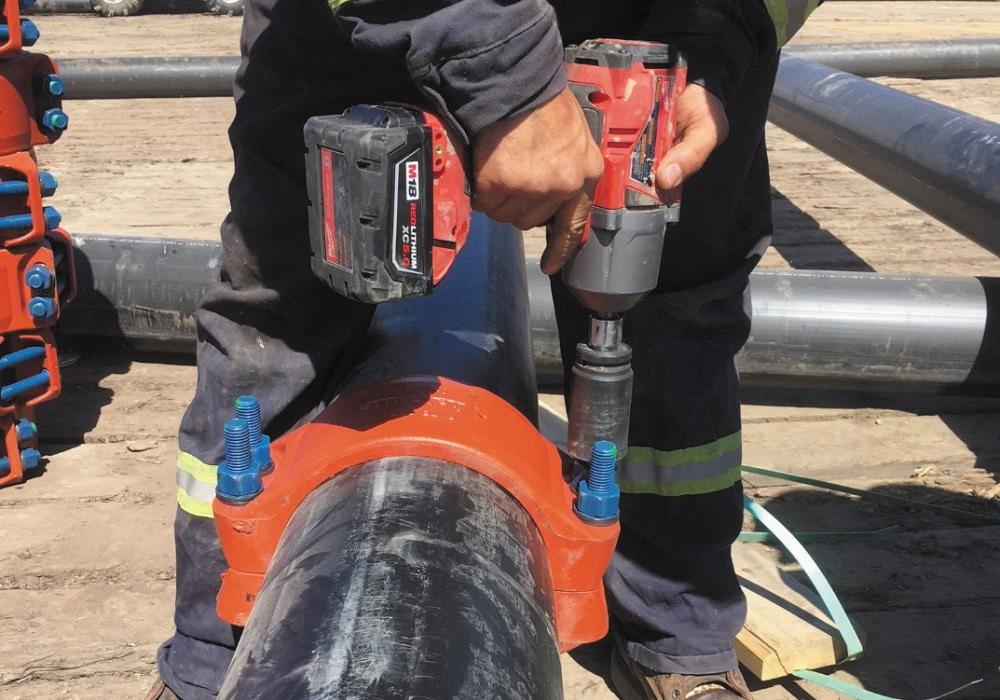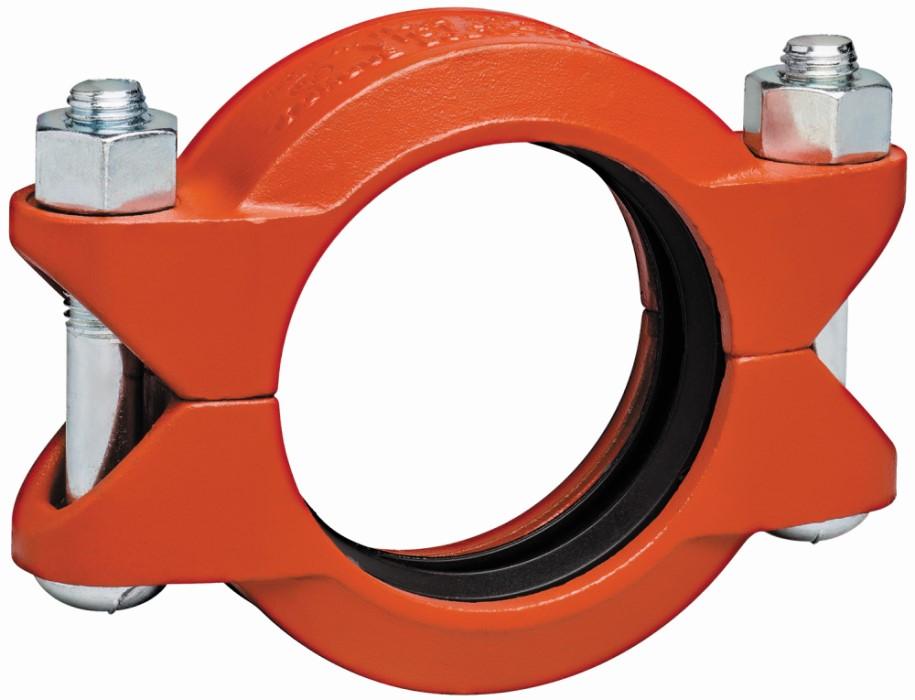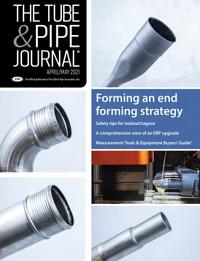- FMA
- The Fabricator
- FABTECH
- Canadian Metalworking
Categories
- Additive Manufacturing
- Aluminum Welding
- Arc Welding
- Assembly and Joining
- Automation and Robotics
- Bending and Forming
- Consumables
- Cutting and Weld Prep
- Electric Vehicles
- En Español
- Finishing
- Hydroforming
- Laser Cutting
- Laser Welding
- Machining
- Manufacturing Software
- Materials Handling
- Metals/Materials
- Oxyfuel Cutting
- Plasma Cutting
- Power Tools
- Punching and Other Holemaking
- Roll Forming
- Safety
- Sawing
- Shearing
- Shop Management
- Testing and Measuring
- Tube and Pipe Fabrication
- Tube and Pipe Production
- Waterjet Cutting
Industry Directory
Webcasts
Podcasts
FAB 40
Advertise
Subscribe
Account Login
Search
Manufacturer uses digital tech to deliver mechanically joined piping systems
Vertical integration from project design to system installation reduces oil, gas, chemical risks
- By Eric Lundin
- May 11, 2021
- Article
- Tube and Pipe Fabrication

Assembling a piping system using mechanically fastened couplers requires little in the way of training or expertise. For the most part, it’s no more complicated than using a wrench. Images: Victaulic
Shorten the timeline. Mitigate the risks. Provide full traceability. Nearly every company in every industry faces ever-tightening demands like these from customers. Whether it’s a matter of minimizing costs, establishing better control over processes, or limiting liability, customers want more and their suppliers have to do more.
Victaulic, a manufacturer of mechanical pipe joining and flow control technologies, is “doing more” for oil, gas, and chemical (OG&C) customers by offering a vertically integrated fabrication solution for piping systems. The company uses many of the latest software packages to enable 3D visualization of each project at the design stage. It then uses value-engineered processes and machinery to create pipe spool assemblies at its own fabrication shops, contributing to the speed and accuracy of the onsite assembly process. Finally, the company ships the assemblies to the jobsite and helps train and support work crews throughout the installation process.
Working Remotely
Compared to a jobsite, work in a fabrication shop offers a lot of predictability. Production orders are scheduled, processes are familiar, tools are at hand, and a support team of supervisors and management is available when things don’t go according to plan.Working at a jobsite means transporting tools, machinery, and materials to the onsite location. Estimates, in turn, must be accurate as the end goal is to bring a site online quickly and begin producing. Yet if the majority of the piping system installation is completed on site, opportunities for risk increase. Whether this risk is in the form of reduced cost certainty, or onsite issues leading to schedule delays, both can keep a facility offline, equating to production losses. When comparing these risks to the certainties realized within the fabrication shop, owners and contractors are quickly realizing the benefits of moving work off the jobsite and into the fabrication facility.
The digital revolution is a big help in reducing or even eliminate the estimates, guesstimates, approximations, and hunches that sometimes substitute for solid information. In the old days, a work site drawing occasionally was incomplete or had an outright error and the installers would have to deal with that on-site. These days, digitization permits paperless tracking from design to installation, helping even the most complex projects go according to plan.
Victaulic brings this concept to the oil, gas and chemical industry. Digital technology helps at the front end, as in-house modeling teams ensure system designs are complete and continuous in the fabrication shop, ensuring the components, subassemblies, and assemblies put together in the shop match the prints. The integrated approach helps at the jobsite, reducing the time needed to set up the system and essentially removing the potential for assembly errors. The workers know they are connecting the equipment correctly, and in the correct sequence, for a successful execution.
The Piping Systems
Victaulic has been delivering innovative system solutions to the oil, gas, and chemical industry for more than 100 years. Installed using ordinary hand tools, its technology provides an alternative to welding, eliminating the need for hard-to-find skilled labor, consumables, and hot work permits.Beyond OG&C, other applications include potable water, wastewater, fire suppression, power generation, and desalination.
Concepts and Designs. Of course, every piping project starts with a design. Victaulic works with the customer to create an initial project model.
“We rely extensively on virtual reality technology to help clients visualize their installation, and we try to be as flexible as we can be,” said Adam Bozick, Victaulic regional sales manager. “If a customer has photos, a sketch, or a 3D model, we can work with any of these.”

Although Victaulic makes thousands of varieties of mechanically joined couplers, a simple one such as the HP-70-3 shows the critical components—a cast split ring, a gasket, and two fasteners.
Regardless of the system’s function, features, or materials, Victaulic assists in the design phase.
“We provide our customers with a variety of programs to choose from,” Bozick said, so Victaulic likely has a software package that corresponds to any customer’s needs. Along with software capabilities, the company also provides customers with a dedicated team of system modelers who develop their project and fabrication drawings. The project team regularly meets with the customer to discuss new developments and collaborate on ways to streamline systems where possible.
After a design is finished and uploaded to Victaulic’s system, it can be accessed by anyone on the team, and this is crucial. Everyone in any industry knows that when a plan is finished, it’s not necessarily finished, and in the old days of paper documentation, any design changes had the potential to pose problems at the job site. Critical steps included approving and logging any design changes, updating drawings, and disseminating them.
Digital systems smooth out any wrinkles in making updates and ensure that everyone on the project has access to the most recent schematic.
Assemble, Pack, and Deliver. Relying on its own fabrication shops means that Victaulic relies on assemblers familiar with the company’s products. It also uses a quality control process that requires a visual inspection of every spool and union to verify proper assembly.The packing stage is critical in getting things done efficiently. Nobody wants to truck too much air to a remote location, but it’s difficult to prevent shipping a lot of air when transporting pipe. It can be a much bigger challenge when hauling pipe assemblies.
Victaulic does everything it can to use each truck’s payload as efficiently as possible. Maximizing a load means minimizing cumbersome subassemblies, so the team assembles everything it can in two dimensions, raising the flat-pack concept to an art form.
Planning the load for efficient workflow means the first items needed are the last ones loaded. This limits product handling and movement and streamlines the build schedule. It also keeps the laydown area to a minimum.
Finally, Victaulic staff accompany the delivery to the worksite, where they support crews with offloading and to provide training on assembly and best practices.
Wrapping It All Up
Victaulic sees its role as going beyond being merely a manufacturer. As a vertically integrated entity, its business model and digital technology can combine to mitigate risk throughout the life cycle of each project it executes. And while the company is more than 100 years old, it understands that in the modern business environment, resting on one’s laurels is not part of the program. Continuous improvement might sound like a buzzword, but in a competitive field—as most fields are these days—it’s a necessity. According to Bozick, the company uses every installation as an opportunity to improve.“On the job site, we monitor the process and the flow, along with the customer, looking for opportunities for improvement,” Bozick said. “This is a competitive marketplace, and we know that to remain competitive, we have to continuously add value and mitigate risk,” he said.
About the Author

Eric Lundin
2135 Point Blvd
Elgin, IL 60123
815-227-8262
Eric Lundin worked on The Tube & Pipe Journal from 2000 to 2022.
About the Publication
Related Companies
subscribe now

The Tube and Pipe Journal became the first magazine dedicated to serving the metal tube and pipe industry in 1990. Today, it remains the only North American publication devoted to this industry, and it has become the most trusted source of information for tube and pipe professionals.
start your free subscription- Stay connected from anywhere

Easily access valuable industry resources now with full access to the digital edition of The Fabricator.

Easily access valuable industry resources now with full access to the digital edition of The Welder.

Easily access valuable industry resources now with full access to the digital edition of The Tube and Pipe Journal.
- Podcasting
- Podcast:
- The Fabricator Podcast
- Published:
- 04/16/2024
- Running Time:
- 63:29
In this episode of The Fabricator Podcast, Caleb Chamberlain, co-founder and CEO of OSH Cut, discusses his company’s...
- Trending Articles
Zekelman Industries to invest $120 million in Arkansas expansion

3D laser tube cutting system available in 3, 4, or 5 kW

Corrosion-inhibiting coating can be peeled off after use

Brushless copper tubing cutter adjusts to ODs up to 2-1/8 in.

HGG Profiling Equipment names area sales manager

- Industry Events
16th Annual Safety Conference
- April 30 - May 1, 2024
- Elgin,
Pipe and Tube Conference
- May 21 - 22, 2024
- Omaha, NE
World-Class Roll Forming Workshop
- June 5 - 6, 2024
- Louisville, KY
Advanced Laser Application Workshop
- June 25 - 27, 2024
- Novi, MI



























